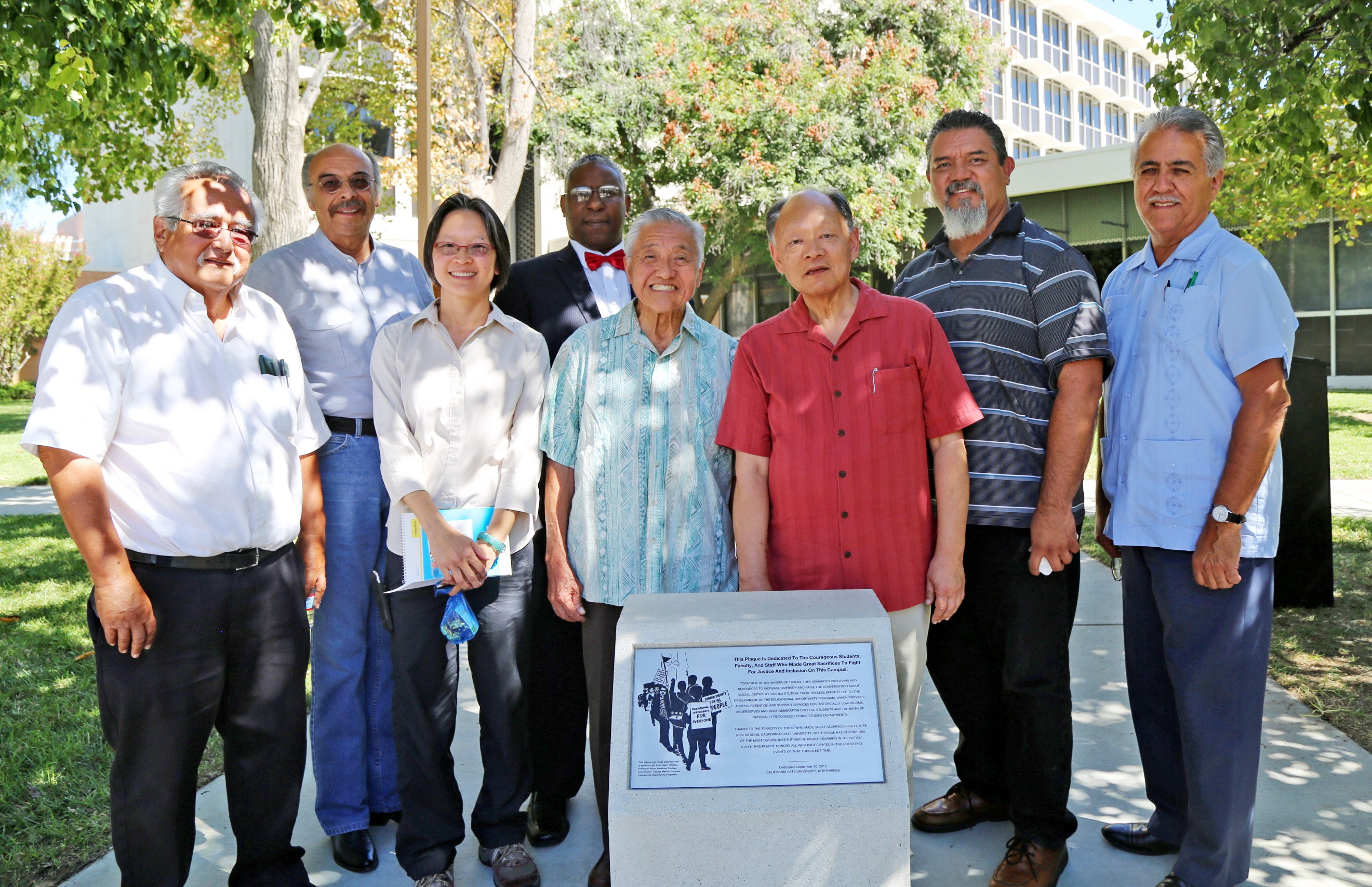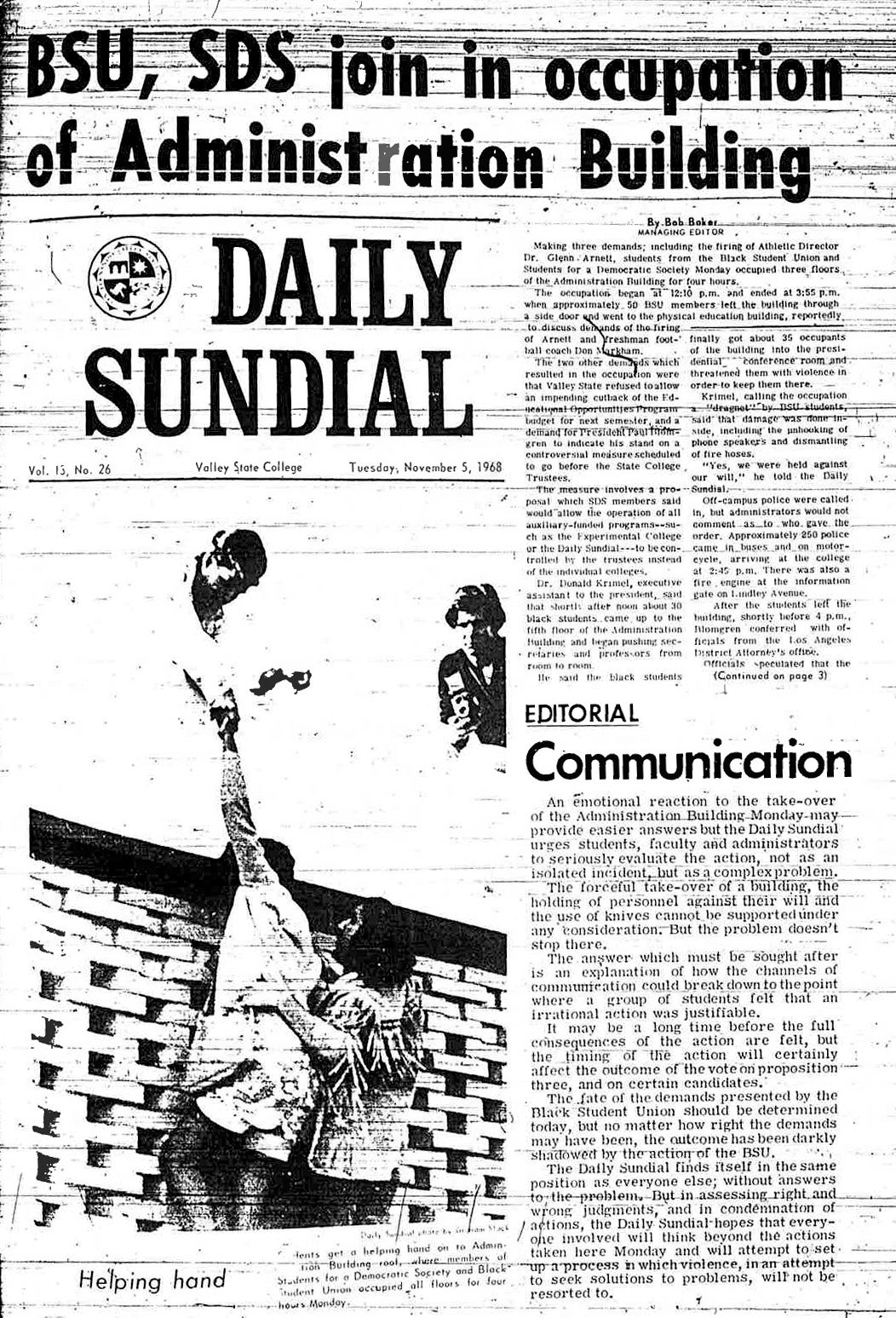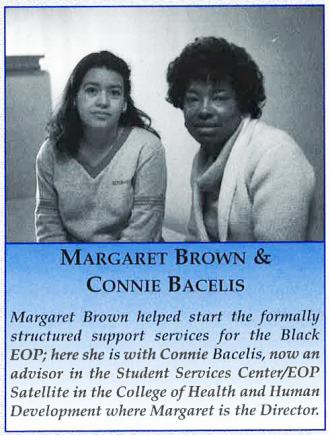EOP emerged from the Civil Rights movement of the late 1960s as a response to the call for access and equity to higher education. As a result of this hard fought, student-led campaign, there is now an EOP at all 23 California State University campuses. EOP remains a critical component of the California State University system because of its commitment to providing access and innovative support services to thousands of underrepresented students.

LEGEND
SFVSC: San Fernando Valley State College (now CSUN)
BSU: Black Student Union
UMAS: United Mexican American Students
SDS: Students For A Democratic Society
EOP: Educational Opportunity Program
Summer 1968
Before the formation of EOP, there were a mere handful of African American and Mexican American students in San Fernando Valley State College, now known as CSUN.
Demands by Black Student Union (BSU) & United Mexican American Students (UMAS), lead to “Project Learn” - recruits & prepares minority students to attend SFVSC in the fall. Approx. 90 freshmen participate in the first Summer “Bridge”.
Fall 1968
SEPTEMBER: 150 Black, 100 Mexican American students attend SFVSC – still less than 2% of the overall student population.
The Educational Opportunity Program (EOP) begins. Stan Charnofsky is named first director of EOP.
NOVEMBER: Several cases of racism occur on campus. BSU along with SDS occupy the administration building until demands are addressed by University President, Dr. Paul Blomgren. Amongst the demands is the expansion of EOP.
*Click here to view the BSU and UMAS demands*
Hundreds of students march to the administration building to see Delmar Oviatt (then standing president) but are met at the doors by riot police. Fighting erupts. 286 students and faculty are arrested for “unlawful” assembly.
Read more about the events that happened on November 4th https://library.csun.edu/SCA/Peek-in-the-Stacks/november-4th-incident
Spring 1969
JANUARY: Activism by students, faculty & community members lead to negotiations with the administration and funding for EOP is secured. EOP generates more access for African & Mexican American students making it necessary to create a curriculum relevant to the student’s experience, in effect the African & Chicano/a Studies Departments are established.
APRIL: EOP is officially established by Senator Harmer’s Senate Bill No. 1072, “State College Educational Opportunity Program”
Learn more about the courageous students, faculty, and staff who made great sacrifices to fight for justice and inclusion at California State University, Northridge (CSUN):
1970
Thanks to the contributions made by Margaret Brown, the concept of peer advisement/peer mentoring was formally inducted as an EOP support service.
1974
The 2 existing EOPs merged. At the time there were 2 EOP; one for Chicano students and one for Black students. In 1975, Keith Bass became the director of the program.
1983
A school-based organizational design begins under the leadership of Dr. Jacqueline Jacobs, then Associate Vice President of Educational Equity and Enrollment Management. This was the beginnings of the College based EOP Satellite services across the university.
1987
Faculty Mentor Program is established as a pilot program through the CSU Office of the Chancellor and placed under the Retention Services unit of Academic Services within Academic Affairs. Retention Services is later renamed Advising Resource Center.
1993
In the Fall, driven by budget deficits and a system-wide goal of consolidating functions at the university, EOP was completely decentralized and the position of EOP Director discontinued.
1994
In the Spring, the Chicana/o Studies and Pan African Studies departments objected strenuously to the dismantling of EOP. Students, staff and faculty marched on the Administration Trailer to demand the reinstitution of an OEP Directory and a centralized program.
1995
José Luis Vargas is appointed Director of EOP

1999
Leaders of EOP and the Faculty Mentor Program initiate the annual Don Dorsey Excellence in Mentoring Awards for faculty and staff on campus.

2004
While attempting to balance the state’s budget, the then governor, Arnold Schwarzenegger, targets EOP and other outreach programs for elimination. Hundreds of EOP staff, alumni and students statewide travel to Sacramento to protest the budget cuts.
2007
EOP put in place a “time capsule” at the Ralph Prator Sundial Fountain. It will be opened in 2029, to commemorate the 60th Anniversary of the Educational Opportunity Programs at California State University, Northridge.
2009
EOP initiates the EOP Resilient Scholars Program (EOP RSP) designed for foster youth on campus. EOP RSP is committed to helping students exiting the foster care system succeed.
In addition, EOP added a 5-week Transfer Bridge Program to the transitional experience. This program is designed for students transferring to CSUN from a community college.
2010
Prior to the CSUN EOP DREAM Center, EOP assembled the AB 540 Initiative. A committee of CSUN and EOP staff available to providing services and resources to students with an AB 540 status. The initiative is now called the EOP DREAM initiative.
2015
The EOP Commemorative Plaque is set near Bayramian Hall in honor of the courageous students, faculty and staff who fought for social justice and equality on campus. It was made possible by late EOP Director, José Luis Vargas, Professor Glenn Omatsu and the support of the CSUN administration. Browse through a full image collection here.

2016
Following the passing of beloved EOP Director José Luis Vargas, hundreds of EOP students and alumni mobilize to defend EOP against attacks by university officials.
2017
Shiva Parsa is appointed Director of EOP
2019
EOP Celebrates its 50 Anniversary Statewide. CSUN EOP hosts a celebration to commemorate the history of the program.



